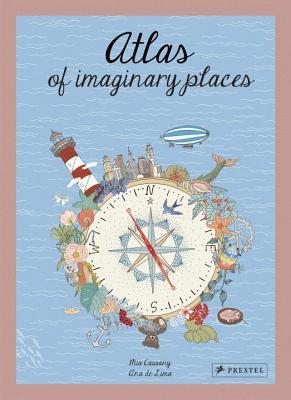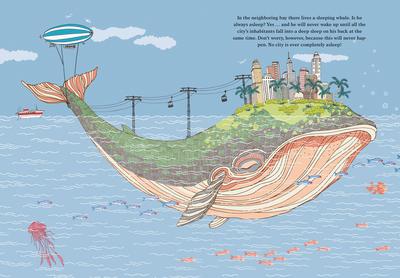Atlas of Imaginary Places
Author: Mia Cassany
Illustrator: Ana de Lima
Published: May 8, 2018 by Prestel Junior
Summary: This dreamy, gorgeously detailed picture book leads children on a journey to impossible but wonderfully imagined places.
Upside-down mountains, volcanoes that spew bubble gum, a gentle humpback whale keeping an entire city afloat. These and other wonderful worlds may not exist on Earth, but elsewhere–who knows? Each spread of this captivating book invites readers on a fantastic voyage. Ana de Lima’s whimsical, softly colored illustrations are filled with surprising details that reward close examination, while Mia Cassany’s soothing narrator is a nameless fellow traveler. A jungle where the animals exchange stripes, spots, and markings each time they sneeze, an archipelago made up of dessert-shaped islands, and a lighthouse so tall you can draw a new galaxy with your finger are just some of the wild places to visit. Perfect for before-bed reading, or daytime dreaming, this stunningly illustrated book will delight young readers and encourage them to conjure their own imaginary places.
My Review: Ever since I finished reading this book (the first time), I have been really looking forward to reviewing it. I cannot get over how wonderfully imaginative it is. It’s absolutely breath-taking. I’ve read it about fifteen times now, and every time, I notice something different. When my son pulls it off of the bookshelf for our nightly reading routine, I silently cheer. I love reading it and pouring through the pages with him. I include a spread below to give you a sense of the gorgeous pages within the book. In the spread featured below, a humpback whale rests just below the surface of the ocean. An entire city is afloat, and the page tells readers that when the city goes to sleep, the whale will wake. But because the city never sleeps, the whale will never wake. I sat with this page for quite some time. I love the magical notion that beneath the surface of the island rests a beautiful, unseen whale. I’ve read thousands of picture books, and this one ranks as one of my favorites. It’s remarkable.
Teacher’s Tools for Navigation: This book belongs in every creative writing class (at all age levels). Teachers might ask students to imagine their own imaginary place. They could write and illustrate a spread, and the spreads could be combined to form a class book. Older writers might examine the prose and the imagination that brings this book alive.
For my Teaching Writing college course, I intend to ask students to select a spread and begin to draft a story. The pages of this book make great story starters. It would also be a great book to talk about setting.
Discussion Questions:
- Which page is your favorite? Why?
- Compare and contrast the pages. What is similar? What is different?
- How do the author and illustrator seem to work to together to make this book come alive?
- What is an imaginary place that you might add to this collection? What would it look like?
Flagged Passage:
Read This If You Loved: What Do You Do with an Idea? by Kobi Yamada; What Do You Do With a Problem? by Kobi Yamada; The Most Magnificent Thing by Ashley Spires; The Dot by Peter H. Reynolds, The Noisy Paint Box by Barb Rosenstock, Lost and Found by Oliver Jeffers, Journey by Aaron Becker
Recommended For:
*Thank you to Casey from Media Masters Publicity for providing this book for an honest review!*





